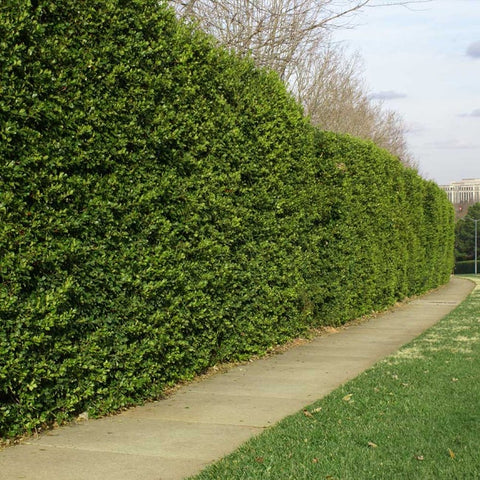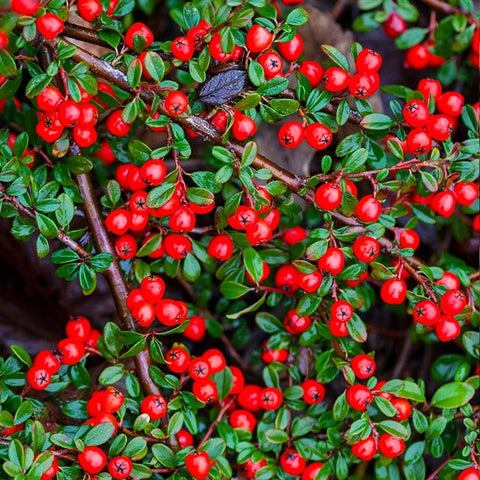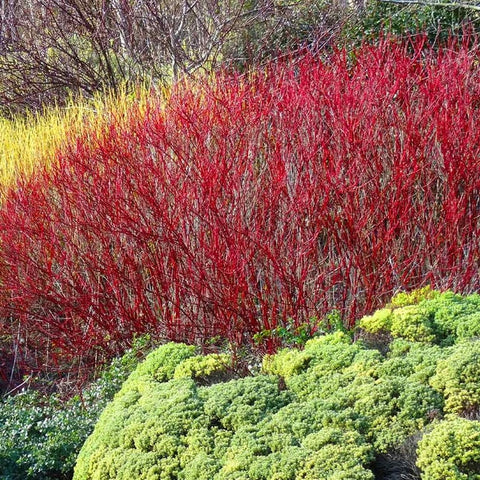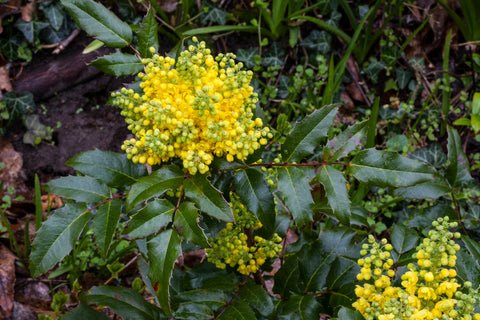January is here, and you may be asking: how can it be a new year when outside everything looks so brown? In your area - though not in mine, here in North Carolina - it could even be white with snow and ice.
Wherever you live, January likely has more of a monochromatic color palette than most other months. But even so, there's plants that are a must-have for interest and color.
The American Holly is one of my favorite plants. Having just finished with the holiday season, my Holly wreath is still alive and well on my door. This Holly can grow up to 50 feet tall, and spread to 40 feet wide.
But that doesn’t mean you can’t have one in your yard, as there are many varieties of this wonderful plant. An added bonus? It provides both warm winter shelter and food for animals, with its dense foliage and red berries. But be aware: while the berries provide food for many species, they're poisonous to humans and pets.

A row of American Hollies, used as a privacy hedge.
If you really want red in your garden, consider a Winterberry Holly. Unlike some Hollies, this is a deciduous plant, meaning that it will lose its leaves in the fall. But after the leaves fall, you'll be left with thousands of red berries clinging to the branches. Winterberry Holly is easy to grow, thriving in most soils and most regions. Depending on the cultivar, it can range from 3 feet to 15 feet in size.
You'll often see these branches cut and used in winter arrangements and decor - meaning you can enjoy the bright red color indoors or out!

The deciduous Winterberry Holly has dense clusters of bright red berries, even after its leaves fall.
Remember, when planting the Winterberry Holly, you must plant a male and female. One male Winterberry can fertilize up to 5 female plants, if planted within 50 feet of the females.
Though not a holly, Callicarpa, or Beautyberry, is a similar shrub grown for the jewel-like purple berries that cluster on its stems throughout autumn and winter. This is a nice option if you want more unique color in your landscape.

The American Beautyberry features bright purple berries.
The Yaupon Holly is another small-leaf Holly that boasts beautiful red, orange or yellow berries. It supplies an excellent habitat and food for songbirds all throughout winter. There's cultivars that offer a variety of shapes and sizes - from dwarf, which look like boxwood, to larger trees.

The Dwarf Yaupon Holly makes an excellent low hedge.
When we're looking for color in our gardens, another suggestion is the beautiful Cotoneaster. Similar to the Hollies, Cotoneaster is a leafy evergreen that puts on a dazzling berry show even in cold winters. These are low-growing, so plant them in front of solid backdrops and their color will really show up.

The bright red berries of the Cotoneaster
And if berries aren't your thing, bark, flowers and vibrantly colored stems can create a dynamic effect as plants enter dormancy.
Dogwood shrubs, including the Red Twig and Yellow Twig Dogwoods, deliver amazing winter color on their long, narrow stems. For the brightest color stems, plant them in full sun.

The bright stems of Red and Yellow Twig Dogwood shrubs add color to winter landscapes.
And lastly, if it's winter fragrance you want, Mahonia will give deliver! Yellow in color, it's highly scented with attractive, evergreen pinnate leaves. Another of my favorite fragrant plants is Daphne. It may be slow-growing and can be on the expensive side, but it's worth it for its highly scented blooms.


